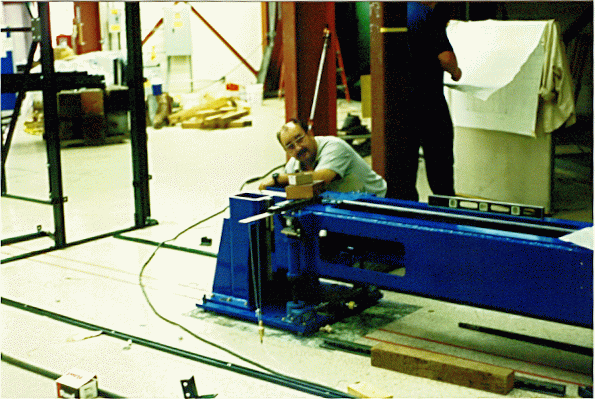
The last year has been a busy one for the Beam Line 9 project staff. A great deal of progress has been made in design and fabrication of components for the beamline and many milestones have been achieved.
The wiggler magnet was received from the manufacturer, Field Effects of Acton, MA. It has been tested and shown to deliver in excess of 2.0 Tesla peak field at the specified minimum pole gap.
The wiggler vacuum chamber fabrication was also a great success. It was fabricated in five precisely machined sections which were then carefully aligned and brazed together to form a 2.3 meter-long assembly which is straight within .010" along its full length. The chamber straightness determines the clear beam aperture and the maximum wiggler field that can be achieved.
This tour de force was accomplished with a design by Mike Baltay and Kane Zuo and was fabricated and assembled under the direction of Andrew Sabersky with extremely valuable support from Martin Byrd and Dale Sartain of SLAC MFD.

The year has not been without its problems, some which have impacted the schedule. Notable is a delay in the delivery for the M0 mirrors from the manufacturer. Due to fabrication facility limitations, the mirrors, which were scheduled for delivery in Oct/Nov '95, are now promised in Feb/Mar '96.
A number of instrumentation and control improvements are being brought about as part of the BL9 project. Tony Cox has successfully ported EPICS from the SUN platform to run on our beam line computers. He and Pierre Capeder have performed motion control tests with this system incorporating supervisory read-back. Tony is now beginning to develop the user interface graphics.
BL9 will be the first SSRL beamline to incorporate Allen-Bradley programmable logic for machine protection (MPS). The A-B SLC500 system will be identical with the system being put in service at SPEAR and is in broad use elsewhere. The BL9 MPS is expected to be the prototype for future beam lines and for upgrading existing systems at SSRL.
System design and procurement are complete and installation began this September. Preliminary planning is underway to link the MPS to EPICS to provide beamline status information to the users.
All in all, the project is moving forward reasonably well and we expect to begin commissioning during the Spring '96 run cycle.